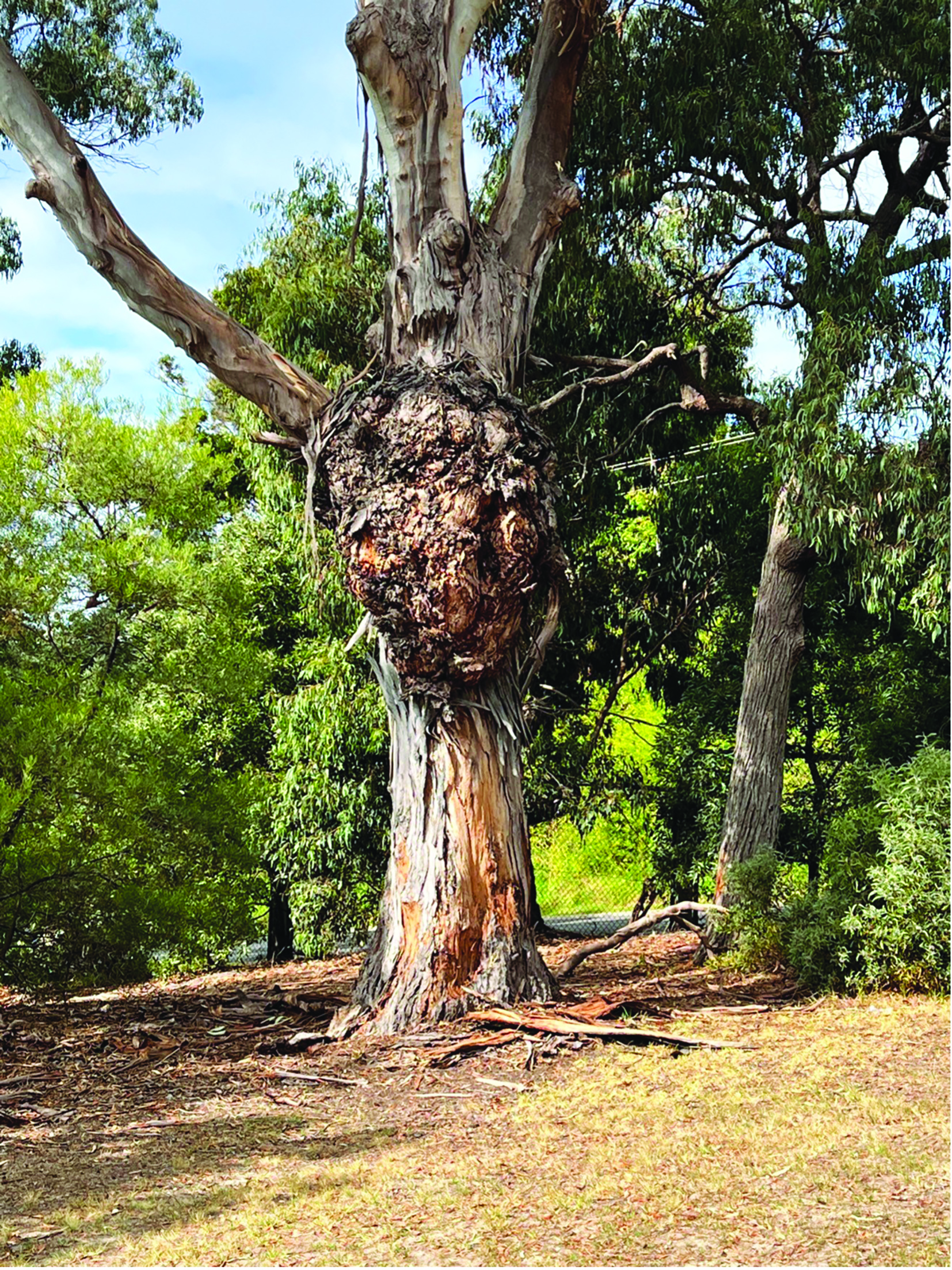Committee for Lorne: The Doomed Diva of Stribling Reserve
While eucalyptus cankers are common throughout our bush gums … just look up, and you will spot them, both large and small … I find it hard not to feel special sympathy for this particularly beautiful gum as it fights its tumorous growth.
If trees could talk—and some believe they can—would our tree speak of discomfort or pain? Would it know that the canker will “get in the end”…just like the cancers that will “get” so many of us and be our end?
However, unlike most human cancers, tree canker is caused by a fungal infection rather than the aberrant, uncontrolled cell division of human malignancies.
While the two words sound alike—’ cancer’ and ‘canker’ sound similar and differ in only a single letter [c for k]—for the most part, that is where the similarity ends. Most human cancers start when an abnormal cell evades the immune system that would normally detect it and “bop it off”, begins to multiply out of control to form a rapidly growing clump, and eventually tends to spread to other parts of the body. Only a handful of human cancers [most often those of the genital organs, liver, and stomach] are thought to be caused by infection. On the other hand, cankers in the plant kingdom are almost always a response to bacterial, virus, or fungal disease.

If a tree is damaged, wounded, or snaps a branch at the trunk, it will commonly attempt self-repair by forming a burr [English] or burl [American]. Its bark heaps up around the wound as it attempts to close the breach. But if the tree is attacked by boring insects, ants, or grubs [like Wichetty grubs], or if the tree’s first line of defence—its bark and cambium layer [the soft outer layer of its trunk]—is breached when the moisture and temperature conditions are favourable for fungal growth, infecting fungal spores may enter, take hold, and multiply. Disordered repair and a tumorous growth [a canker] can then result.
Anyone who has seen how fungal infections can spread beneath a damaged toenail to fester, lift the nail, and cause inflammation will get the picture.
Though viruses or bacteria can cause some cankers, eucalyptus cankers are most commonly the result of infection with one of the Cryphonectria or Cytospora families of fungi, with some of our more than 900 individual species of gums more susceptible than others. These fungal spores, borne on the wind or trapped by raindrops, can lodge under the damaged outer layer of the trunk [the cambium layer] to fester and grow, especially if the moisture and temperature conditions are favourable.
In the bush, such infections are usually left to take their natural course, and while some trees might survive, most will eventually succumb to leaf dieback or snap, break, and fall—in part or in whole—at the weakened spot. That said, cankered trees near human habitation, pathways, or roads may need removal for safety reasons. However, the current addiction of our authorities to “an abundance of caution” needs careful balancing with the aesthetics of our natural environment.
Of course, canker disease can affect almost any tree. Eucalyptus grandis [the rose gum] “stands out from most other gums for its rapid growth rate and ability to regenerate, making it a sustainable choice in forestry practices” [see: https://www.australianwoodwork.com.au/], but is also particularly susceptible to canker formation. Lots of botanical research is currently underway to understand the canker process better.
Currently, early detection and treatment by an arborist of any significant wounds by trimming, clean-cutting, pasting and binding is our only shot in the locker. Although some orchardists may spray their fruit trees with some rather nasty chemicals, the widespread dispersal use of antifungals is expensive and impractical, especially in the forestry industry. In addition, their local application [by painting, injecting, or smearing the canker surface] is broadly unsuccessful … it is like shutting the gate after the horse is away and over the hill.
Among the most susceptible to canker disease are the river red gums that line our inland rivers [like the Murray], the forest red gum—like our Men’s Shed beauty, and the beautiful blue gum—like those on Scotchman’s Hill overlooking the Lorne surf beach.

I was of two minds writing this story. While I love that old tree and the gnarled twists and tortured shapes wrought by its fatal disease that fascinate me, I fear that by drawing it to the attention of the powers that be, they may be prompted to remove it before it drops the cankered branch, its canopy dies back or—worse—the tree breaks and falls. It is not likely to do much damage or cause injury from where it stands, and it still seems—to my untrained eye—to be maintaining its structural integrity. Nevertheless, it is doomed, one way or another, to death from disease or the arborist’s chainsaw.
Our tree is not the only one on borrowed time. Drive along the Great Ocean Road, Deans Marsh Road, or on any of a dozen bush access tracks [like Garveys or Sharps tracks], and you will notice myriad trees marked for removal with a small, yellow-painted circle. These trees, identified by forestry arborists as hollow at their core, have been deemed structurally suspect, a fire risk, or both.
Sadly, they also make perfect hidey holes for native birds and animals that look on from the undergrowth as their homes and shelters are cut down, helpless to intervene in the cull. Again, that fine line between ‘our’ safety and environmental protection must be carefully drawn and wisely trodden. To cull mature trees that have stood for over a century and may last for another—all in the name of potential human risk—is a weighty decision.
Returning to our beautiful ‘diva’ in front of The Men’s Shed … should it stay or go? That is another weighty question. Aesthetics says stay; safety might say go. But if it is not yet on a watch list, this story may prompt it to be. In the meantime, I will continue to marvel at its complex canker and whisper soft words of encouragement—just in case it is listening.
John Agar
Feature Writer
A word from the chairman
Hello
Our Chairman John and his lovely wife Janet are currently sojourning in Spain leaving it to the rest of us to shoulder the burden of one of his many duties, writing the Chairman’s column for the weekly Committee for Lorne page in the Surf Coast Times.
Over the next few weeks, we will have a number of guest writers contributing to this column. The idea of a page in the Surf Coast Times was the brainchild of our previous Chairman, Ian Stewart. Ian stated in words like “why don’t we get a page in the Surf Coast Times over December and through to February when the crowds are here so we can bring them news from the Committee? It’s only for a few weeks, so it shouldn’t be hard to get content.” Well, that was 10 years ago and the page is STILL going!
So, one of our contributing columnists will be, you guessed it, Ian Stewart. Our Councillor, Gary Allen will also contribute a column. If anyone in our community feels the urge to write a column, you are most welcome, subject to editorial scrutiny. Just email tour contribution, 450-500 words, to [email protected].
-0-0-0-0-
John’s departure to Europe prompts one to think about the signs that the summer season with its crowds, events and general “buzz” is over for another year. Lorne locals are planning their holidays in warmer areas of Australia or overseas. Port Douglas seems to become Lorne Mk II during winter but now that we are no longer dealing with the impact of COVID many more from our community are planning overseas holidays. That’s one of the signs. Another is to drive through the Top Bank Caravan Park and see wide open spaces where only a few weeks ago the place was chock full of caravans and a bewildering array of other camping gear. What a treat it is to drive along Mountjoy Parade and have a choice of car parking spaces. So much choice! Except for the weekends when to day trippers come to visit. It’s great for the economy I hope, but it does make one yearn for Monday when the street is quiet once more.
Another sign that the season is over is so few people on the beach. At the moment, we are experiencing very low tides and, in the mornings lately when low tide is around 8am to 9am, there is sooo much beach and sooo few people. It’s a wonderful place to wander and throw a ball for the dog. Another sign that winter is approaching? The meet and greet in the Hospital waiting room while we all line up for our flu injections!
Lorne is a place of seasonal contrast. Each season is different and has its own personality. I for one, am grateful to be able to experience the variety of seasons in such a special place. For those travelling on, enjoy the trip. For those hunkering down in Lorne, enjoy what Lorne has to offer over the cooler months. It’s a pretty nice place to be.
Pete Spring
Lorne Ward Events Calendar
May
11th – Lorne Dolphins Football and Netball V South Colac, at Stribling Reserve, juniors match from 9am, seniors at 2pm
12th – Lorne Country Club Mother’s Day Evening of Fun – Drinks, Dinner, Raffles and Comradery from 6pm
25th – Lorne Dolphins Football and Netball V Birregurra, at Stribling Reserve, juniors match from 9am, seniors at 2pm
June
8th – Lorne Market, 9-3pm https://www.lornemarkets.com/
8th – Lorne Dolphins Football and Netball V Colac Imperials, at Stribling Reserve, juniors match from 9am, seniors at 2pm


















